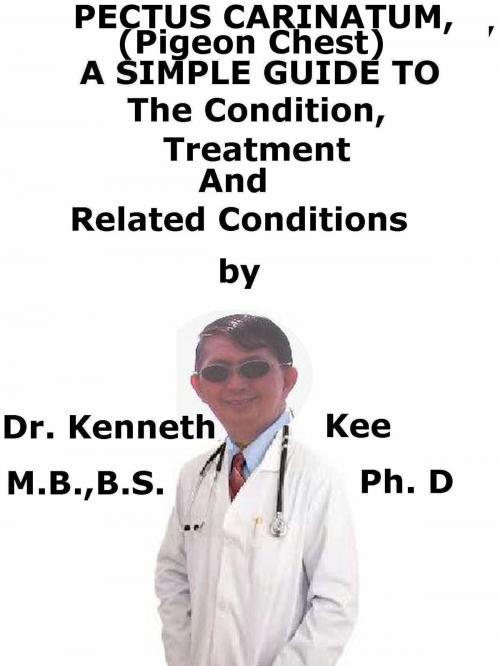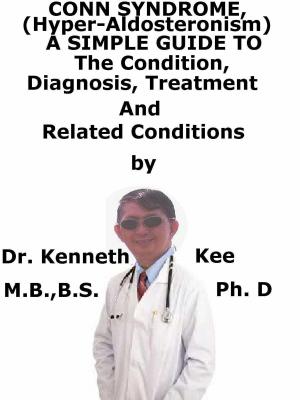Pectus Carinatum, (Pigeon Chest) A Simple Guide To The Condition, Treatment And Related Conditions
Nonfiction, Health & Well Being, Health, Ailments & Diseases, Musculoskeletal, Medical, Specialties, Orthopedics| Author: | Kenneth Kee | ISBN: | 9781370768196 |
| Publisher: | Kenneth Kee | Publication: | October 21, 2016 |
| Imprint: | Smashwords Edition | Language: | English |
| Author: | Kenneth Kee |
| ISBN: | 9781370768196 |
| Publisher: | Kenneth Kee |
| Publication: | October 21, 2016 |
| Imprint: | Smashwords Edition |
| Language: | English |
Pectus carinatum or Pigeon Chest is a deformity of the chest characterized by a protrusion of the sternum and ribs.
In this condition the sternum is raised (carina = keel).
It is a condition where there is a protrusion of the chest over the sternum often described as giving the person a bird-like appearance.
It is the opposite of pectus excavatum.
Pectus carinatum may occur as a single abnormality or in association with other genetic disorders or syndromes.
The condition causes the sternum to protrude with a narrow depression along the sides of the chest.
This gives the chest a bowed-out appearance similar to that of a pigeon.
People with pectus carinatum generally develop normal hearts and lungs but the deformity may prevent these from functioning optimally.
It used to be associated with rickets.
Nowadays there is usually an associated history of severe asthma in childhood sometimes with a ventricular septal defect (VSD).
20% of patients have an associated scoliosis.
There is some evidence that pectus carinatum may prevent complete expiration of air from the lungs in children.
These young people may have a decrease in stamina even if they do not realize it.
Pectus deformities can have a significant psychological impact on the children.
Some children live happily with pectus carinatum especially if it is mild.
For others the shape of the chest can damage their self-esteem and self-confidence possibly affecting social communication with others.
The most common cause for pectus carinatum seems to be in the 11-14 year old pubertal male who is undergoing a growth spurt
The second most common is from birth.
It is evident in newborns as a rounded chest and as they reach 2 or 3 years old the sternum begins to grow outwardly even more.
The least common way is post surgically after open heart surgery.
Some patients develop a rigid chest wall resulting in reduced vital capacity and symptoms of:
1. Dyspnea,
2. Exertional tachypnea
3. Reduced endurance
Physical examination can diagnose the condition.
Electrocardiography and echocardiography may be needed to rule out cardiac abnormalities and assess cardiac function.
Pulmonary function testing may be useful to determine the impact of the deformity on the performance of the heart and lungs.
CT scanning may be helpful
Many patients have a mild deformity with no associated morbidity requiring treatment.
A brace may be used to treat children and young adolescents by suppressing the growth of the protrusion.
If there is significant pulmonary or cardiac dysfunction, open surgical repair is performed.
TABLE OF CONTENT
Introduction
Chapter 1 Pectus Carinatum
Chapter 2 More Facts of Pectus Carinatum
Chapter 3 Treatment of Pectus Carinatum
Chapter 4 Kyphoscoliosis
Chapter 5 Scoliosis
Chapter 6 Kyphosis
Chapter 7 Costochondrosis
Chapter 8 Pectus Excavatum
Epilogue
Pectus carinatum or Pigeon Chest is a deformity of the chest characterized by a protrusion of the sternum and ribs.
In this condition the sternum is raised (carina = keel).
It is a condition where there is a protrusion of the chest over the sternum often described as giving the person a bird-like appearance.
It is the opposite of pectus excavatum.
Pectus carinatum may occur as a single abnormality or in association with other genetic disorders or syndromes.
The condition causes the sternum to protrude with a narrow depression along the sides of the chest.
This gives the chest a bowed-out appearance similar to that of a pigeon.
People with pectus carinatum generally develop normal hearts and lungs but the deformity may prevent these from functioning optimally.
It used to be associated with rickets.
Nowadays there is usually an associated history of severe asthma in childhood sometimes with a ventricular septal defect (VSD).
20% of patients have an associated scoliosis.
There is some evidence that pectus carinatum may prevent complete expiration of air from the lungs in children.
These young people may have a decrease in stamina even if they do not realize it.
Pectus deformities can have a significant psychological impact on the children.
Some children live happily with pectus carinatum especially if it is mild.
For others the shape of the chest can damage their self-esteem and self-confidence possibly affecting social communication with others.
The most common cause for pectus carinatum seems to be in the 11-14 year old pubertal male who is undergoing a growth spurt
The second most common is from birth.
It is evident in newborns as a rounded chest and as they reach 2 or 3 years old the sternum begins to grow outwardly even more.
The least common way is post surgically after open heart surgery.
Some patients develop a rigid chest wall resulting in reduced vital capacity and symptoms of:
1. Dyspnea,
2. Exertional tachypnea
3. Reduced endurance
Physical examination can diagnose the condition.
Electrocardiography and echocardiography may be needed to rule out cardiac abnormalities and assess cardiac function.
Pulmonary function testing may be useful to determine the impact of the deformity on the performance of the heart and lungs.
CT scanning may be helpful
Many patients have a mild deformity with no associated morbidity requiring treatment.
A brace may be used to treat children and young adolescents by suppressing the growth of the protrusion.
If there is significant pulmonary or cardiac dysfunction, open surgical repair is performed.
TABLE OF CONTENT
Introduction
Chapter 1 Pectus Carinatum
Chapter 2 More Facts of Pectus Carinatum
Chapter 3 Treatment of Pectus Carinatum
Chapter 4 Kyphoscoliosis
Chapter 5 Scoliosis
Chapter 6 Kyphosis
Chapter 7 Costochondrosis
Chapter 8 Pectus Excavatum
Epilogue















